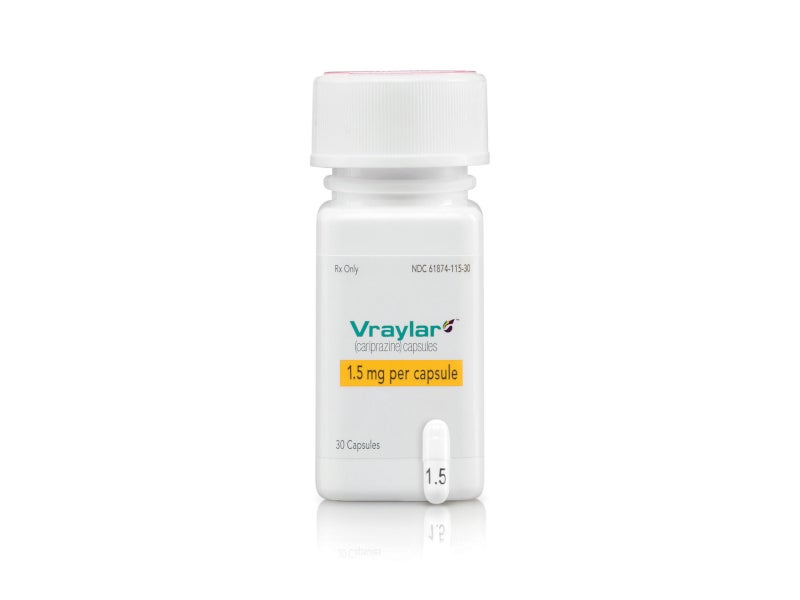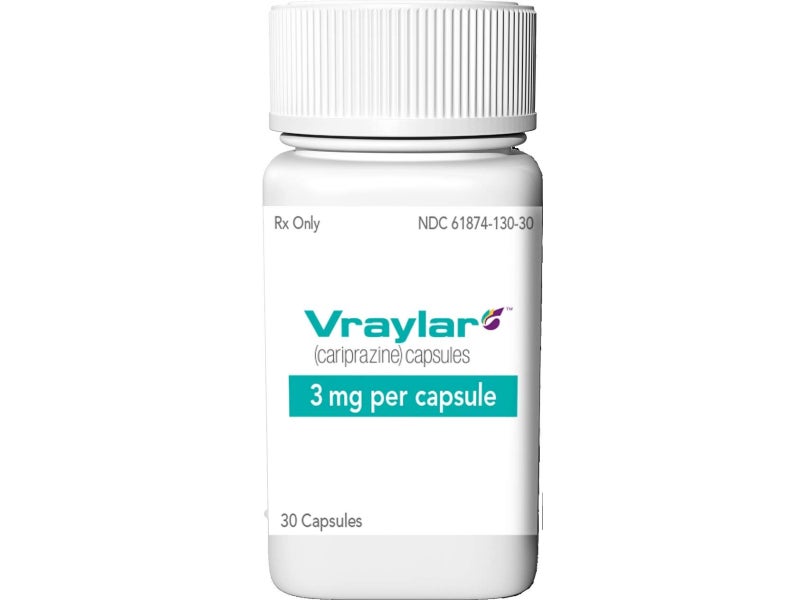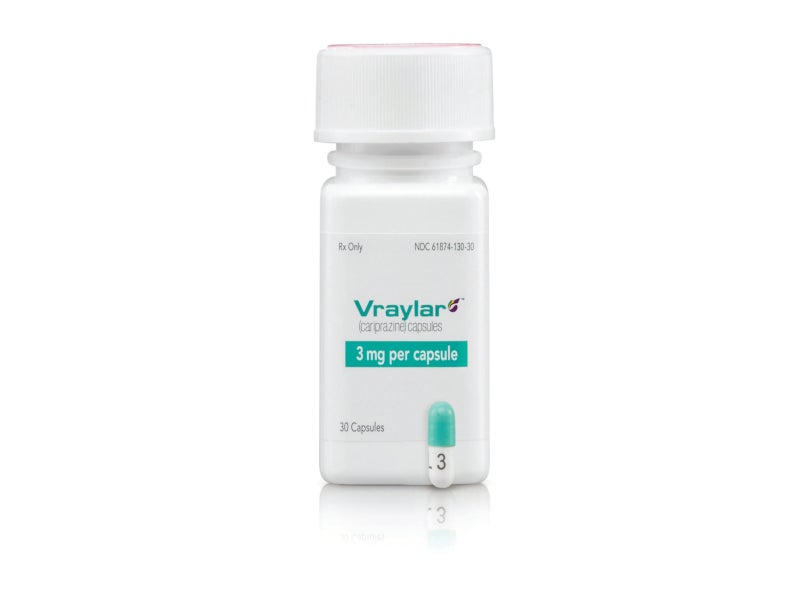Vraylar® (cariprazine) is an atypical antipsychotic drug indicated for the treatment of adults with bipolar I disorder, and schizophrenia, as well as an adjunctive treatment for major depressive disorder (MDD) with antidepressants.
The drug is the first and only dopamine and serotonin partial agonist that the US Food and Drug Administration (FDA) approved for some of the most common types of depression, including the depressive episodes associated with bipolar I disorder and an adjunctive treatment for MDD.
Designed for specific mood disorders, Vraylar was discovered and co-developed by Gedeon Richter and licensed to Allergan (now part of Abbvie) in the US and Canada.
Vraylar (cariprazine) are available in four dosage strengths, 1.5mg capsules with white cap and body, 3mg capsules with green to blue-green cap and white body, 4.5mg capsules with green to blue-green cap and body, and 6mg capsules with a purple cap and white body for oral administration.
Regulatory approval for Vraylar
The drug was first approved by the FDA in September 2015 for the acute treatment of manic or mixed episodes associated with bipolar I disorder and schizophrenia. The drug received approval from the European Commission (EC) in July 2017 and is marketed under the brand name Reagila in Europe.
In August 2016, Richter agreed to provide an exclusive licence to Recordati for the commercialisation of cariprazine in Western Europe, Algeria, Tunisia and Turkey.
In November 2017, the FDA expanded the drug’s indication as a maintenance therapy to treat schizophrenia in adult patients. The indication was expanded in May 2019 to include the treatment of adults with bipolar depression, which are depressive episodes related to bipolar I disorder.
In May 2019, Richter entered an exclusive licence agreement with Seqirus to provide the drug in Australia and New Zealand.
In June 2019, Richter and Allergan expanded their agreement, allowing the latter to register the drug in Argentina, Venezuela, Brazil, Peru, Chile, Mexico, Colombia and Ecuador.
Richter also signed an agreement to provide Hikma Pharmaceuticals with exclusive rights to commercialise cariprazine in Bahrain, the UAE, Egypt, Syria, Jordan, Sudan, Iraq, Qatar, Saudi Arabia, Oman, Kuwait, Morocco, Lebanon and Libya, in July 2019.
The drug also secured regulatory approval for treating schizophrenia patients in Singapore and Thailand, in August 2019. Mitsubishi Tanabe Pharma has the license to commercialise the drug in Singapore and Thailand.
In February 2023, the FDA approved Vraylar as an adjunctive therapy to antidepressants for treating MDD in adults, which marks the drug’s fourth indication.
Causes and symptoms of MDD, bipolar I disorder and schizophrenia
MDD is a mental disorder typically associated with mood swings that cause persistent sadness, anhedonia, guilt, worthlessness, fatigue, poor concentration, appetite changes, psychomotor retardation or agitation, sleep disturbances, or suicidal thoughts.
It is usually caused by an imbalance of neurotransmitters, such as serotonin and dopamine, contributing to depression. Other factors also include hereditary, unpleasant life events or certain illnesses, medication and medical conditions, being easily irritated or frustrated, excessive eating or less eating, insomnia, hypersomnia, fatigue, and lack of concentration. Sometimes, it can also develop without a clear trigger and can vary from mild to severe.
MDD was ranked as the third cause of the burden of disease globally in 2008 by the World Health Organisation (WHO), which has projected that this disease will rank first by 2030. MDD is one of the most common mental disorders in the US.
Bipolar I disorder and schizophrenia are chronic mental health disorders. Patients with bipolar I disorder often experience mood swings, fluctuations in energy and activity levels and difficulty in conducting day-to-day tasks. It affects approximately 3.6 million people in the US.
Schizophrenia is associated with hallucinations, speech difficulties and poor social behaviour. Symptoms of the disorder broadly fall under three categories, namely positive, negative and cognitive. An estimated 2.6 million adults suffer from schizophrenia in the US.
Vraylar’s mechanism of action
Though Vraylar’s mechanism of action in treating bipolar I disorder and schizophrenia is not clearly known, its efficacy could be linked to the combination of partial agonist activity and antagonist activity exhibited at the central dopamine D2 and serotonin 5-HT1A 5-HT2A receptors.
While cariprazine acts as a partial agonist at the dopamine D3 and D2 receptors, it acts as an antagonist at serotonin 5-HT2B and 5-HT2A receptors.
Cariprazine forms two significant metabolites, desmethyl cariprazine (DCAR) and didesmethyl cariprazine (DDCAR), with in vitro receptor binding profiles like the parent drug.
Clinical trials on Vraylar
The FDA approval for Vraylar was based on the results from a clinical trial programme conducted to establish the safety and efficacy of the drug in patients with manic or mixed episodes of bipolar I disorder and schizophrenia.
The drug’s efficacy in the treatment of schizophrenia was established in three six-week, randomised, double-blind and placebo-controlled trials. The primary and secondary efficacy measures to assess psychiatric signs and symptoms in each trial were determined using the positive and negative syndrome scale (PANSS) and Clinical Global Impressions-Severity (CGI-S) rating scales. The primary endpoint in each study was the change from baseline in PANSS total score at the end of week six.
The drug demonstrated efficacy at doses between 1.5mg/day and 9mg/day compared to placebo. The maximum recommended dose, however, was fixed at 6mg/day following the observance of adverse reactions with an increase in the dose.
Vraylar’s efficacy in the acute treatment of bipolar disorder was observed in three three-week, placebo-controlled trials. The primary and secondary efficacy measures to assess the psychiatric signs and symptoms were determined using the Young Mania Rating Scale (YMRS) and the Clinical Global Impressions-Severity scale (CGI-S). The primary endpoint in each study was the decrease from baseline in YMRS total score at the end of week three.
The most common adverse reactions observed during the trials for bipolar mania included extrapyramidal symptoms, akathisia, dyspepsia, vomiting, somnolence and restlessness, while those observed in schizophrenia patients were extrapyramidal symptoms and akathisia.
The drug’s approval as an adjunct therapy for MDD was based on the data from phase III clinical trials based on Montgomery-Åsberg Depression Rating Scale (MADRS) score. The phase III clinical trials involved two studies, namely 3111-301-001 and a second registration-enabling study, RGH-MD-75 for a period of six to eight weeks, respectively.
The drug demonstrated a clinically and statistically significant change from baseline to week six in MADRS score. The drug was well tolerated during the trial.
The most common adverse reactions observed in the adjunctive MDD studies were Akathisia, nausea, insomnia, restlessness, fatigue, constipation, increased appetite, dizziness and extrapyramidal symptoms.






